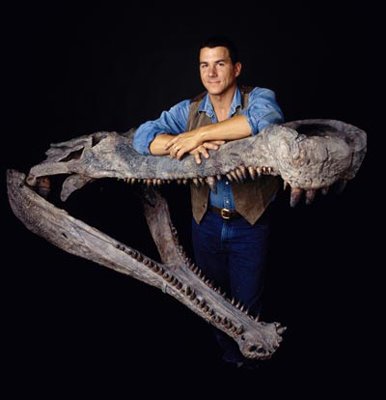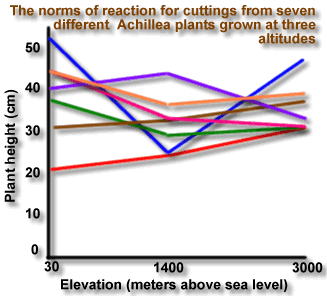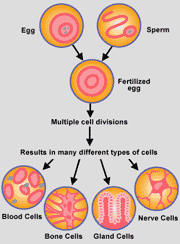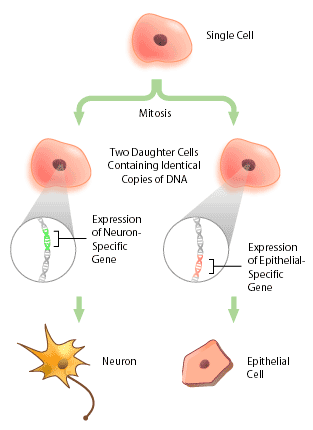BIO101 - Bora Zivkovic - Lecture 3 - Part 1
Imagine that you are a zebra, grazing in the savannah. Suddenly, you smell a lion. A moment later, you hear a lion approaching and, out of the corner of your eye, you see the lion running towards you.
What happens next? You start running away, of course. How does that happen? Your brain receieved information from your sensory organs, processed that information and made a decision to puruse a particular action. That decision is relayed to the muscles that do the actual running.
In short, that is behavior and it can be schematically depicted like this:
Environment---------> Sensor ----------> Integrator---------> EffectorHere, the change in the environment (appearance of a lion) is perceived by the sensors (eyes, nose, ears), processed by the effector (the brain) and results in the activity of the effectors (muscles).
But, it is usually not that simple. The flow chart, as depicted, may be accurate when describing behavior of a bacterium, a protist, a fungus or a plant. A molecule in the cell membrane of a bacterium may sense nutrients, toxins or light. This information is processed by the cell as a whole, and as a result, the cilia or flagella move the bacterium in an appropriate direction.
Specialized cells in the shoot-tips or root-tips may detect up and down, or the position of the Sun, and guide growth in an appropriate direction (shoots up, roots down). Sunflowers and some other plants track the position of the Sun throughout the day. Many plants open and close their flowers or leaves at particular times of day. Some flowers, e.g, Venus flytrap and some orchids, can move even faster in order to capture insects.
Pilobolus, a fungus (seen as fine white fuzz on manure), shoots its spores towards the Sun at a particular angle at a particular time of day. Those are all simple behaviors involving a single sensor, a single integrator and a single effector in a simple unidirectional flow of information.
Once we get to animals with central nervous systems, things get a little bit more complicated. There are often multiple sensors. In the zebra example, the changes in environment are detected by three separate sensors: for vision, audition and olfaction. Effectors are many muscles, working in a highly coordinated manner.
Sensors located in the muscles feed the information about their activity back to the integrator. Integrator feeds back to the sensors as well - raising the sensitivity of the sensory organs, including vision, hearing, smell and the tactile sense (touch), while reducing the sensitivity of other sensors, e.g., for pain. The subjective perception of the rate of passage of time slows down, allowing for more fine-grained sensation and faster decision-making by the integrator.
Furthermore, the integrator will stimulate secretion of the hormones which, in turn, may increase the ability of effectors (muscles) to do their work. Integrator will also raise the activity of other organ systems that are important in allowing muscles to perform at their maximal level, e.g., circulatory and respiratory systems that bring oxygen and energy to the muscles.
At the same time, the brain temporarily shuts down the activity of organ systems not neccessary for short-term survival, but which may take the valuable energy away from the muscles. Thus, the digestive, immune, excretory and reproductive systems are inhibited.
As the zebra runs away, the act of running results in subsequent changes in the environment, which are again detected by the sensors. The integrator makes decisions to suddenly sverve if the lion gets closer, or to buck and kick if the lion gets very close, or to stop and find the safest route back to the herd if the lion has abandoned the chase.
All the changes described in the zebra example above are elements of the
stress response, which is an excellent example of a complex behavior. There are multiple sensors, multiple effectors, various modifications of the body's physiology, and several kinds of information feedbacks involved. Behavioral biology studies all aspects of it.
In addition, it is not just the activity itself, but also the
propensity for such activity that is studied by behavioral biology.
Probability of a behavior happening depends on the
motivation, or the
state of the effector. The state can be modified by hormones, hunger, tiredness, libido, general energy levels, etc. The effector (e.g, the brain) also possesses
timing mechanims (clocks and celandars) which make some behaviors much more likely during the day or during the night, some more likely during spring or summer, others more likely during fall or winter.
What Is Behavior?It is difficult to define behavior without resorting to just listing examples of various kinds of behaviors, but let's try to define it anyway:
Behavior is a change in body's position, shape or color, or a change in potential for such change, in response to changes in the external or internal environment. Behavior is endogenously generated (i.e., if I move your arm - that is not your behavior, it's mine), purposive (meant to achieve a goal), and is an evolved adaptation that contributes to survival or reproduction, thus increases one's fitness (which is obvious in the case of the fleeing zebra).
How to study behavior?The most informative and profitable way to study behavior is an
integrative approach. This means that the behavior under study is approached at all
levels of organization (from molecules to ecosystems) and from four different angles. The first angle is
Mechanism, which denotes study of the physiology underlying behavior. Most of the analysis of the zebra's behavior described above focused on this aspect - the physiology of the sensory, neural, muscular and other systems and the way they work together to produce the behavior.
The second one is
Ontogeny, the study of embryonic and post-embryonic development of the behavior - how does an individual acquire the behavior, how much is the behavior inherited vs. learned, at what time in one's life cycle can the behavior be learned or expressed, at what times of day or year are the behaviors most likely to be expressed, etc.
These first two angles - mechanism and ontogeny - are sometimes called
Proximate Causes of behavior and are designed to ask and answer the "How" questions of behavior (how does it work, how does it develop). The next two are called
Ultimate Causes of behavior and are designed to ask and answer the "Why" questions (why behave in such way).
History is the third approach. It studies the evolutionary history of a behavioral trait, usually by employing the
comparative method, i.e., comparison of a number of related species, trying to discover if the behavior is common in all of them, in which case it is present due to the deep
phylogenetic history, or of it most reliably varies with the type of environment the species lives in, suggesting that the behavior is a
recent adaptation for a particular way of life. Finally, the fourth approach is
Function. It tests the hypothesis that the behavior in question increases the animal's fitness, aids in survival and/or reproduction, and has evolved for that function - is it an
adaptation.
Recently a fifth question has been added to this list.
Animal cognition asks “Can animals think?” Here, careful use of some unusual (and quite controversial) methods, including anecdotes, introspection and anthropomorphism, aids in the development of testable hypotheses about the inner worlds of animals.
No other area of biology is as integrative as behavioral biology. It is possible for a biochemist to ignore ecology or for an ecologist to ignore biochemistry (though at the risk of performing irrelevant research), but a behavioral biologist cannot ignore any aspect of the biology of the species under study. This makes the study of behavior the glue that holds all of biology together. This makes behavioral biology difficult to do, as one needs to have strong background in many areas of biology, technical expertise in a broad range of laboratory and field techniques, and lots of time to follow up on the literature in a number of related fields.
Only a few - the best - behavioral biologists are capable of exploring every aspect of a behavior at all levels. Mostly, the problem is divided among a number of laboratories around the world, each researcher using a slightly different approach and different techniques. The laboratories then communicate with each other via formal channels - the publications in scientific journals - and via informal channels - conferences and personal communication. Thus, a big picture is slowly being built out of its smaller parts, each piece of research being informed by all other pieces of research.
Types of behaviorsForaging behavior involves finding, catching, handling and ingesting food. It includes the formation and use of feeding territories, learning the hunting techniques, the physiology of hunger, as well as behavioral strategies for avoiding becoming prey.
Animal
movement includes, most prominently, long-distance migration including the neural mechanisms of spatial orientation and navigation.
Communication is the ability of animals to communicate information to each other (within and betwen species) via several
sensory channels (or modalities). Those modalities include vision (including infrared, ultraviolet and polarized light, as well as thermoreception), sound (including ultrasound, infrasound and substrate vibrations), chemical signals (smells, pheromones, taste), touch and electrical signals (as in electrical fish).
Reproductive behaviors encompass a broad range of behaviors. Mate-finding, male-male competition, mate-choice and courtship are behaviors involved in securing a mate. Mating behavior ensures fertilization. Nesting and parenting behaviors are meant to ensure the survival of the offspring.
Reproductive behaviors are important elements of evolutionary change. Many phenotypic traits are a result not of natural selection, but of
sexual selection, where a trait is selected not by the physical environment but by potential mates. Traits favored by the individuals of the opposite sex tend to be more likely to be passed on to the next generation in that population. This leads to the evolution of exaggerated traits (e.g., the peacock's tail) and to differences between sexes (e.g., in many bird species the male is brightly colored while the female looks drab).
Mate choice can, potentially, be involved in sympatric speciation, if different individuals in the population favor different traits in their mates, so the gene flow between the two groups gets progressively smaller with each generation. This kind of mating is called
assortative mating (as opposed to
random mating, where each individual is equally likely to mate with each individual of the opposite sex).
The most common types of
mating systems are monogamy, polygyny, and polyandry. A good example of
polygyny is the elephant seal in which only one male (after defeating all the other males in one-on-one fights) mates with all the females in his territory.
Polyandry is found only a little less often - one female mates with multiple males over the course of a breeding season, resulting in her offspring being of mixed paternity (i.e., different eggs were fertilized by different males). This has been studied mostly in frogs.
Monogamy is the rarest form of mating strategy in the animal kingdom. A distinction is made between
social monogamy and
sexual monogamy. Many animals that form breeding pairs, including most species of birds, are engaged in social monogamy - the male and the female build the nest together, mate and raise the chicks together. However, DNA fingerprinting has shown that a small proportion of the eggs is invariably fertilized by a different male - a fleshy neighbor who may not be a good "husband" and "father", but whose size, bright colors or powerful song indicate other genetic qualities. Thus, some of the progeny of the same female will be fleshy sons, some will be "good husband" sons and some will be daughters - the female is hedging her bets about the production of grandoffspring.
Humans are not officially classified as monogamous animals - though human polygamy (both polygyny and polyandry) tends to be in the form of
serial monogamy, i.e., sticking monogamously with one partner for a particular length of time, then changing the partner. Social norms have strongly opposed, but did not eradicate human non-monogamy. Increased life-span, invention of reliable contraception, and economic independence of women are making it more and more difficult to supress the non-monogamous tendencies in humans, as seen from statistics for divorce (around 50%), re-marrying, and cheating (around 60% of both men and women) that have held quite steady over the past 50 years or so.
Social behaviors involve relationships between individuals of the same species. Some animals tend to live alone, each individual defending a territory, and a male and a female meeting only briefly during the mating season. Other animals tend to live in smaller or larger groups. Some animals change their social structure seasonally - for instance, European quail live in coveys (10-12 birds) during the winter), in huge flocks during spring and fall migrations, and in breeding pairs during summer.
Within groups, there is often a hierarchy of individuals - the so-called "pecking order". The
social hirearchy is established through
aggression, often in form of ritualized displays. In many species, the ritualized aggressive behaviors are so-called "
fixed-action patterns", i.e., a strongly heritable order of particular movements. Mating behaviors are also often fixed-action patterns.
In some species, the mating fixed-action patterns are also used for aggressive encounters. In some cases, when a male mounts another male utlizing a typical mating pattern, this is actually a display of
social dominance. However, in other species, a male mounting a male is actually homosexual behavior, evolved not to determine social hirearchy, but quite the opposite, to increase
social coherence within the group ("making friends"). In pygmy chimps (bonobos), everyone in a troup mates with everyone else in the troup, regardles of gender. This makes the troup socially cohesive (which helps in group's defense if attacked by another troup).
Read:Peter H. Raven, George B. Johnson, Jonathan B. Losos, and Susan R. Singer, Biology (7th edition), McGraw-Hill Co. NY, Chapter 52.
Previously in this series:Biology and the Scientific MethodCell StructureProtein Synthesis: Transcription and TranslationCell-Cell InteractionsCell Division and DNA ReplicationCell Differentiation and Embryonic DevelopmentGenotype and PhenotypeEvolutionTechnorati Tag: teaching-carnival

























